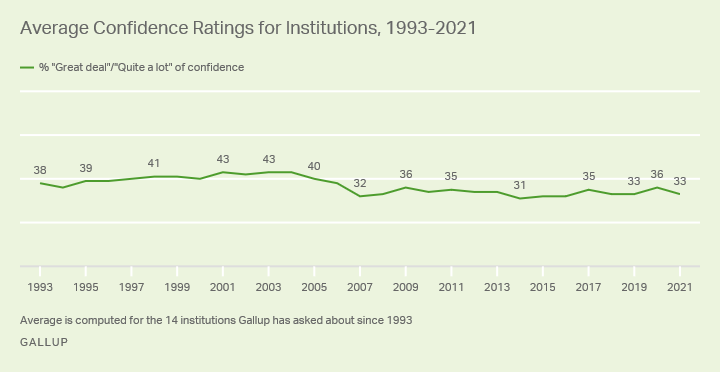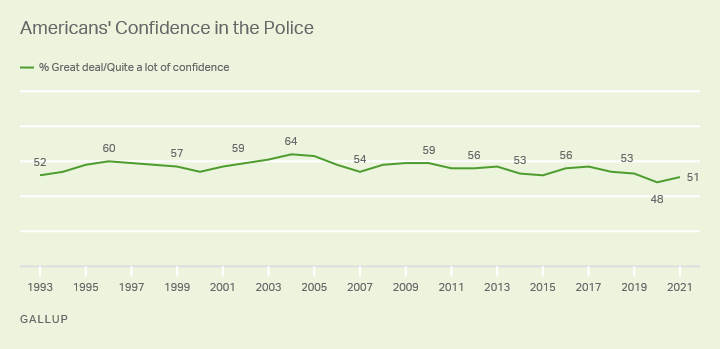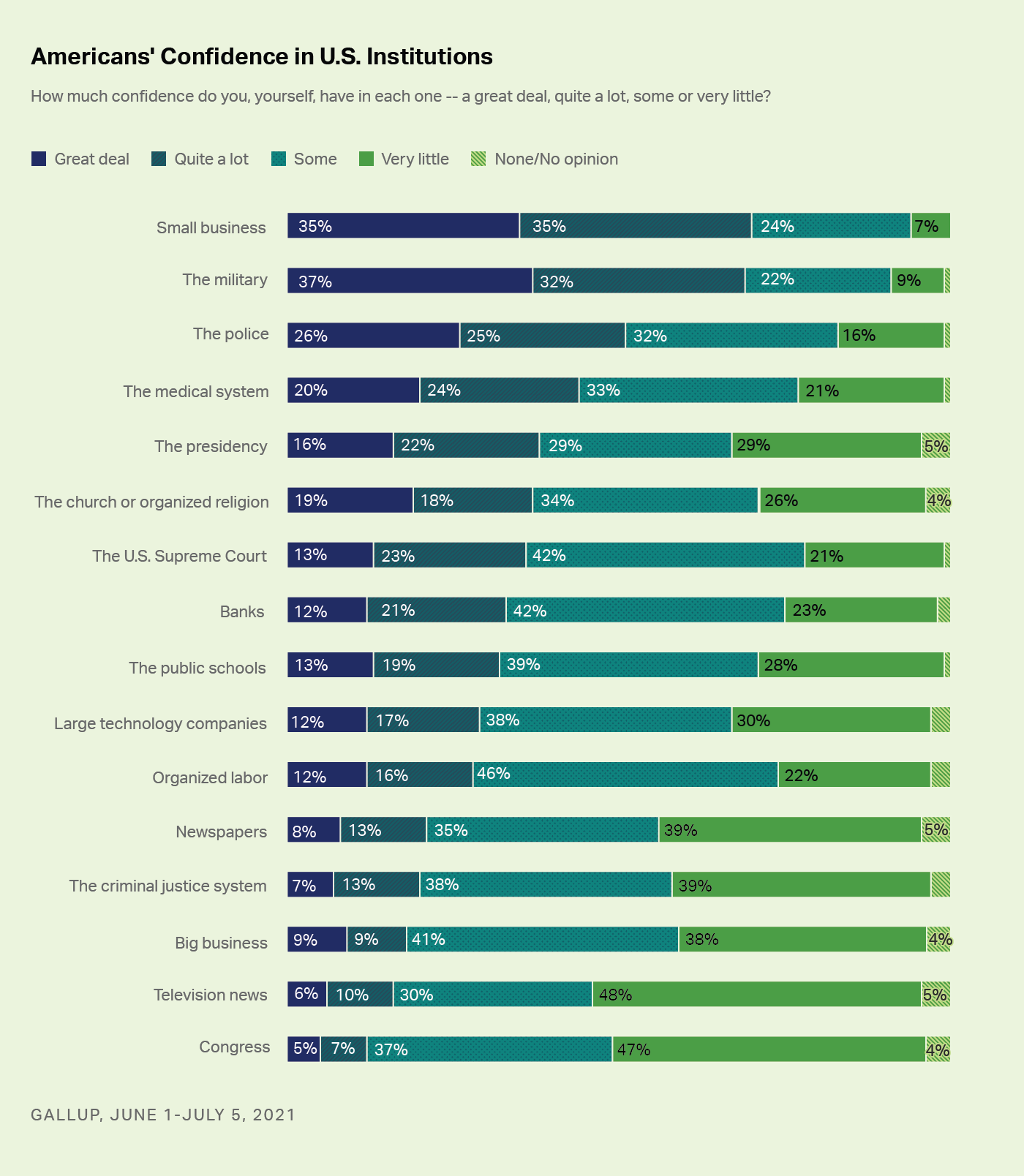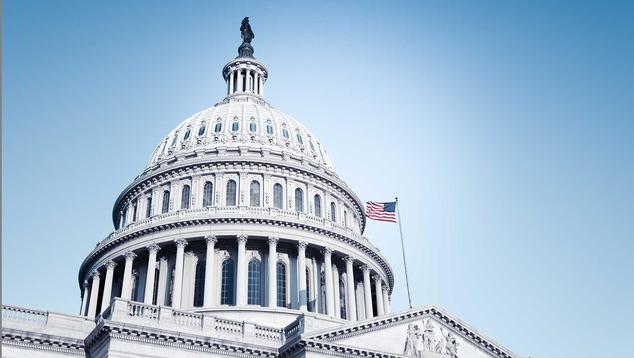Story Highlights
- 33% average confidence in 14 major institutions, down from 36% in 2020
- Public schools, medical system down after double-digit increases in 2020
- Small business, military elicit the most confidence; Congress, the least
WASHINGTON, D.C. -- Americans' average confidence in major U.S. institutions has edged down after increasing modestly several months into the coronavirus pandemic last year. Currently, an average 33% of U.S. adults express "a great deal" or "quite a lot" of confidence in 14 institutions, marking a three-percentage-point dip since 2020 and a return to the level seen in 2018 and 2019.

Line graph. Average confidence ratings for 14 institutions since 1993. The 33% average in 2021 is a slight decline from 36% in 2020 and well below the 43% highest on record, seen in the early 2000s.
These findings, from a June 1-July 5 poll, are the latest in Gallup's tracking of the public's confidence in a variety of key U.S. institutions, which began in 1973 during the Watergate scandal. Gallup has tracked 14 core institutions since 1993, and the public's confidence in them has remained relatively low -- particularly over the past 15 years, when the average has not risen above 36%. Before 2006, averages at or above 40% were more common. In addition to the core institutions, Gallup measures confidence in other societal institutions, though with less frequency.
Confidence in Most Institutions Down After Increases in 2020
In 2020, confidence in several specific institutions increased as the nation dealt with the effects of the coronavirus pandemic. These include some of the business and societal sectors most affected by the public health and financial effects of the coronavirus situation, including the medical system, public schools, small business, organized religion and banks. This year, these same five institutions show the greatest decreases in confidence. However, they all are perceived at least slightly better than they were in 2019 before the pandemic. In particular, confidence in the medical system is substantially higher now (44%) than it was two years ago (36%).
Confidence in the U.S. Supreme Court and the criminal justice system are each down four points since 2020 and remain below their 2019 levels. Meanwhile, decreases since last year in Americans' confidence in eight other institutions are not statistically significant. These include the military, technology companies, organized labor, newspapers, television news, the presidency, big business and Congress.
In addition to big business, the police was the only other institution that saw a drop in confidence between 2019 and 2020. Since then, confidence in the police has edged up three points, to a slim 51% majority.
| 2019 | 2020 | 2021 | Change, 2021 vs. 2020 | |
|---|---|---|---|---|
| % | % | % | pct. pts. | |
| The public schools | 29 | 41 | 32 | -9 |
| The medical system | 36 | 51 | 44 | -7 |
| Small business | 68 | 75 | 70 | -5 |
| The church or organized religion | 36 | 42 | 37 | -5 |
| Banks | 30 | 38 | 33 | -5 |
| The U.S. Supreme Court | 38 | 40 | 36 | -4 |
| The criminal justice system | 24 | 24 | 20 | -4 |
| The military | 73 | 72 | 69 | -3 |
| Technology companies | -- | 32 | 29 | -3 |
| Organized labor | 29 | 31 | 28 | -3 |
| Newspapers | 23 | 24 | 21 | -3 |
| Television news | 18 | 18 | 16 | -2 |
| The presidency | 38 | 39 | 38 | -1 |
| Big business | 23 | 19 | 18 | -1 |
| Congress | 11 | 13 | 12 | -1 |
| The police | 53 | 48 | 51 | +3 |
| Gallup | ||||
Last year's confidence reading for the police, which was taken in the aftermath of George Floyd's killing and the related nationwide protests, was the lowest on record and the first time it was below majority level. While the latest three-point uptick is not statistically significant, the measure remains shy of its 2019 level. Further analysis of the racial differences in confidence in the police is available here.

Line graph. Percentage of Americans who have a great deal or quite a lot of confidence in the police, trend since 1993. The 2021 reading of 51% is three points higher than last year's lowest on record. Though recovered somewhat, 51% is among the lowest ratings for the police.
Overall Confidence Rankings Remain Fairly Stable
The police are one of just three institutions in which a majority of Americans express a great deal or quite a lot of confidence. The other two -- small business and the military -- have consistently ranked at the top of the list since 1989.
At the other end of the spectrum are Congress, television news, big business, the criminal justice system and newspapers, each of which has a confidence rating at or below 21%. Congress or big business has ranked at the bottom of the list since 2007.
The other eight institutions earn middling confidence ratings from the public, ranging from 28% for organized labor to 44% for the medical system.

Bar graphs. Americans' confidence in 16 institutions. Small business, the military, and the police are the only institutions with majorities of Americans expressing a great deal or quite a lot of confidence.
Confidence in Most Institutions Politically Polarized
Majorities of Republicans and Republican-leaning independents, as well as Democrats and Democratic-leaning independents, express confidence in the military and small business. Both party groups express similarly low confidence in the Supreme Court, big business, banks and the criminal justice system.
However, partisans' confidence in the remaining 10 institutions diverges. Republicans have far more confidence than Democrats in the police and the church. Meanwhile, Democrats' confidence in the other eight institutions outpaces Republicans' by double digits.
| Republicans/Leaners | Democrats/Leaners | Rep-Dem difference |
|
|---|---|---|---|
| % | % | pct. pts. | |
| The police | 76 | 31 | +45 |
| The church or organized religion | 51 | 26 | +25 |
| The military | 78 | 62 | +16 |
| Small business | 76 | 64 | +12 |
| The U.S. Supreme Court | 39 | 35 | +4 |
| Big business | 19 | 17 | +2 |
| Banks | 35 | 33 | +2 |
| The criminal justice system | 20 | 19 | +1 |
| Congress | 7 | 17 | -10 |
| Large technology companies | 22 | 34 | -12 |
| The medical system | 36 | 50 | -14 |
| Television news | 6 | 25 | -19 |
| Organized labor | 16 | 39 | -23 |
| The public schools | 20 | 43 | -23 |
| Newspapers | 8 | 35 | -27 |
| The presidency | 13 | 62 | -49 |
| GALLUP, June 1-July 5, 2021 | |||
The largest partisan gap in confidence for any institution is for the presidency, with 49 points separating Democrats' and Republicans' ratings. Confidence in the presidency has become increasingly linked to the party affiliation of the president, with supporters of the president's party much more confident than supporters of the opposition party, consistent with the greater party polarization in presidential job approval ratings. Between 1993 and 2004, the average party gap in confidence in the presidency was 34 points. Since then, it has averaged 50 points.
Bottom Line
When the coronavirus pandemic hit the U.S. in 2020, it caused great upheaval in most aspects of Americans' lives. It also resulted in an overall uptick in average confidence across 14 institutions, driven largely by sharp one-year increases -- among the largest Gallup has measured -- for the U.S. medical system and public schools. Now, with the worst of the pandemic seemingly over and the intensity of the racial justice protests subsiding, Americans' confidence has retreated to more typical levels seen in recent years.
Average confidence in the 14 institutions Gallup has tracked long-term continues to lag behind where it has been historically. The pandemic thrust many U.S. institutions into the spotlight, and the discussion of these institutions' roles in the pandemic has been controversial at times. Grappling with how to set policies to contain the spread of the pandemic while simultaneously attempting to limit its impact on economic, educational and faith activities has proven challenging.
To stay up to date with the latest Gallup News insights and updates, follow us on Twitter.
View complete question responses and trends (PDF download).
Learn more about how the Gallup Poll Social Series works.




